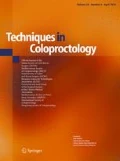Abstract
Background
Lengthening of the colon for tension-free low rectal anastomosis comprises ligation of the inferior mesenteric vessels and splenic flexure mobilization. The aim of our study was to evaluate the length gained after each level of mesenteric vessel ligation with or without splenic flexure mobilization.
Methods
The length of the colon after each mobilization technique, that is, low ligation of the inferior mesenteric artery (IMA), high ligation of IMA, high ligation of the inferior mesenteric vein (IMV), and mobilization of splenic flexure, was measured in 13 cadaveric specimens. After each step, the colon and vessels were placed back in their original position.
Results
The distance from the colosigmoid junction (CSJ) to the pubic symphysis (PS) was measured after each mobilization technique. The average elongation of the colon from original CSJ–PS distance to the CSJ–PS distance after low ligation of IMA, high ligation of IMA, high ligation of IMA plus splenic flexure mobilization, and high ligation of IMV was 2.08 ± 4.39 cm, 5.02 ± 5.51 cm, 8.20 ± 5.95 cm, and 17.98 ± 6.80 cm, respectively. The length of colon gained after IMV ligation was greater than the length obtained after low ligation of IMA, high ligation of IMA, and high ligation of IMA plus splenic flexure mobilization (p < 0.0001).
Conclusions
This study shows the objective length gained following each standard surgical technique in colonic mobilization for low rectal anastomosis. The maximum length gained is after high ligation of IMV.


Similar content being viewed by others
References
Ferlay J, Parkin DM, Steliarova-Foucher E (2010) Estimate of cancer incidence and mortality in Europe in 2008. Eur J Cancer 46:765–781
Rafferty JF (2001) Obtaining adequate bowel length for colorectal anastomosis. Clin Colon Rectal Surg 14:25–31
Buunen M, Lange MM, Ditzel M, Kleinrensink GJ, van de Velde CJ, Lange JF (2009) Level of arterial ligation in total mesorectal excision (TME): an anatomical study. Int J Colorectal Dis 24:1317–1320
Eaton MA, Valentine J, Jackson MR, Modrall G, Clagett P (2000) Incidental splenic injury during abdominal vascular surgery: a case-controlled analysis. J Am CollSurg 190:58–64
Holubar SD, Wang JK, Wolff BG et al (2009) Splenic salvage after intraoperative splenic injury during colectomy. Arch Surg 144:1040–1045
Katory M, Tang CL, Koh WL et al (2008) A 6-year review of surgical morbidity and oncological outcome after high anterior resection for colorectal malignancy with and without splenic flexure mobilization. Colorectal Dis 10:165–169
Brennan DJ, Moynagh M, Brannigan AE, Gleeson F, Rowland M, O’Connell PR (2007) Routine mobilization of the splenic flexure is not necessary during anterior resection for rectal cancer. Dis Colon Rectum 50:302–307
Kim J, Choi DJ, Kim SH (2009) Laparoscopic rectal resection without splenic flexure mobilization: a prospective study assessing anastomotic safety. Hepatogastroenterology 56:1354–1358
Titu LV, Tweedle E, Rooney PS (2008) High tie of the inferior mesenteric artery in curative surgery for left colonic and rectal cancers: a systematic review. Dig Surg 25:148–157
Acknowledgments
The authors thank Prof. Dr. Supasit Pannarunothai, Department of Community Family and Occupational Medicine, Faculty of Medicine, Naresuan University, for his suggestions regarding statistical analyses. We also thank Assistant Prof. Dr. Sutatip Pongcharoen, Research Office, Faculty of Medicine, Naresuan University for help in preparing the manuscript and Mr. Pikom Sirisopausa for drawing the figures.
Conflict of interest
None.
Author information
Authors and Affiliations
Corresponding author
Rights and permissions
About this article
Cite this article
Thum-umnuaysuk, S., Boonyapibal, A., Geng, Y.Y. et al. Lengthening of the colon for low rectal anastomosis in a cadaveric study: how much can we gain?. Tech Coloproctol 17, 377–381 (2013). https://doi.org/10.1007/s10151-012-0930-6
Received:
Accepted:
Published:
Issue Date:
DOI: https://doi.org/10.1007/s10151-012-0930-6




